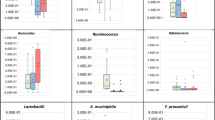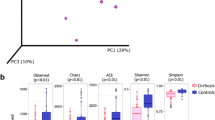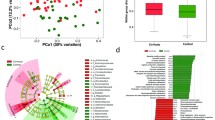Abstract
Human liver was closely associated with gut through various biological mechanisms, such as bacterium–gut interactions. Alterations of gut microbiota seemed to play an important role in induction and promotion of liver damage progression. The aim of this study was to characterize the gut microbiota in liver cirrhosis patients and assess whether there are alterations in the diversity and similarity of intestinal flora in cirrhotic patients when compared with healthy individuals. PCR-denaturing gradient gel electrophoresis (DGGE) with universal primers targeting V3 region of the 16S rRNA gene was employed to characterize the overall intestinal microbiota composition, and some excised gel bands were cloned for sequencing. Real-time PCR was further utilized to quantitatively analyze the subpopulation of microbiota using group-specific primers targeting the Enterobacteriaceae, Enterococcus and Bifidobacterium genus. The DGGE profiles of two groups demonstrated significant differences between cirrhotic and healthy groups (P < 0.05). While real-time PCR revealed significant increase of Enterobacteriaceae and Enterococcus (P < 0.05) in the cirrhotic group compared with the healthy group. The ratio of Bifidobacterium genus and Enterobacteriaceae decreased in the cirrhotic patients group, but no statistical significance. This study revealed strong relationship between alterations of gut microbiota and liver cirrhosis.


Similar content being viewed by others
References
Abt MC, Artis D (2009) The intestinal microbiota in health and disease: the influence of microbial products on immune cell homeostasis. Curr Opin Gastroenterol 25:496–502
Ahmed S, Macfarlane GT, Fite AJ et al (2007) Mucosa-associated bacterial diversity in relation to human terminal ileum and colonic biopsy samples. Appl Environ Microbiol 73:7435–7442
Bäckhed F, Ley RE, Sonnenburg JL et al (2005) Host-bacterial mutualism in the human intestine. Science 307:1915–1920
Balamurugan R, Rajendiran E, George S et al (2008) Real-time polymerase chain reaction quantification of specific butyrate-producing bacteria, Desulfovibrio and Enterococcus faecalis in the feces of patients with colorectal cancer. J Gastroenterol Hepatol 23:1298–1303
Cani PD, Delzenne NM (2009) The role of the gut microbiota in energy metabolism and metabolic disease. Curr Pharm Des 15:1546–1558
Cesaro C, Tiso A, DelPrete A et al (2011) Gut microbiota and probiotics in chronic liver diseases. Dig liver Dis 43:431–438
Dorigo U, Volatier L, Humbert JF (2005) Molecular approaches to the assessment of biodiversity in aquatic microbial communities. Water Res 39:2207–2218
Duncan SH, Hold GL, Barcenilla A et al (2002) Roseburia intestinalis sp. nov., a novel saccharolytic, butyrate-producing bacterium from human faeces. Int J Syst Evol Microbiol 52:1615–1620
Farhadi A, Gundlapalli S, Shaikh M et al (2008) Susceptibility to gut leakiness: a possible mechanism for endotoxaemia in non-alcoholic steatohepatitis. Liver Int 28:1026–1033
Fromin N, Hamelin J, Tarnawski S et al (2002) Statistical analysis of denaturing gel electrophoresis (DGE) fingerprinting patterns. Environ Microbiol 4:634–643
Gavin PG, Victoria SL, Graham JR et al (2005) Statistical analyses of complex denaturing gradient gel electrophoresis profiles. J Clin Microbiol 43:3971–3978
Goris H, de Boer F, Vnder WD (1988) Kinetics of endotoxin release by Gram-negative bacteria in the intestinal tract of mice during oral administration of Bacitracin and during in vitro growth. Scand J Infect Dis 20:213–219
Guarner C, Sriano G, Tmas A et al (1993) Increased serum nitrite and nitrate levels in patients with cirrhosis: relationship to endotoxemia. Hepatology 18:1139–1143
Guarner F, Malagelada JR (2003) Gut flora in health and disease. The Lancet 61:512–519
Hooper LV, Midtvedt T, Gordon JI (2002) How host-microbial interactions shape the nutrient environment of the mammalian intestine. Annu Rev Nutr 22:283–307
Hopkins MJ, Sharp O, Macfarlane GT (2001) Age and disease related changes in intestinal bacterial populations assessed by cell culture, 16S rRNA abundance, and community cellular fatty acid profiles. Gut 48:198–205
Jan W, Maria HE, Roland M, Carl EN (1993) Pathogenesis of urinary tract infection-experimental studies of vaginal resistance to colonization. Pediatr Nephrol 7:509–514
Lay C, Sutren M, Rochet V, Saunier K et al (2005) Design and validation of 16S rDNA probes to enumerate members of the Clostridium leptum subgroup in human faecal microbiota. Environ Microbiol 7:933–946
Ledder RG, Gilbert P, Huws SA et al (2007) Molecular analysis of the subgingival microbiota in health and disease. Appl Environ Microbiol 73:516–523
Leser TD, Amenuvor JZ, Jensen TK et al (2002) Culture-independent analysis of gut bacteria: the pig gastrointestinal tract microbiota revisited. Appl Environ Microbiol 68:673–690
Ley RE, Backhed F, Turnbaugh P et al (2005) Obesity alters gut microbial ecology. Proc Natl Acad Sci USA 102:11070–11075
Li YT, Li W, Yu C et al (2010) Effects of gut microflora on hepatic damage after acute liver injury in rats. J Trauma 68:76–83
Lin CJ, Lee FY, Lee SD et al (1995) Endotoxemia in patients with chronic liver diseases: relationship to severity of liver diseases, presences of esophageal varices, and hyperdynamic circulation. J Hepatol 22:165–172
Lu HF, Wu JW, Wei X et al (2011) Intestinal microbiota was assessed in cirrhotic patients with hepatitis B virus infection. Microb Ecol 61:693–703
Mariat D, Firmesse O, Levenez F et al (2009) The Firmicutes/Bacteroidetes ratio of the human microbiota changes with age. BMC Microbiol 9:123–131
Matsuki T, Watanabe K, Fujimoto J et al (2002) Development of 16S rRNA-gene-targeted group-specific primers for the detection and identification of predominant bacteria in human feces. Appl Environ Microbiol 68:5445–5451
Miele L, Valenza V, La Torre G et al (2009) Intestinal permeability and tight junction alterations in nonalcoholic fatty liver disease. Hepatology 49:1877–1887
Gerard Muyzer (1999) DGGE/TGGE a method for identifying genes from natural ecosystems. Curr Opin Microbiol 2:317–322
Norman K, Pirlich M (2008) Gastrointestinal tract in liver disease: which organ is sick? Curr Opin Clin Nutr Metab Care 11:613–619
Phillips ML (2009) Gut reaction environment effects on the human microbiota. Environ Health Perspect 117:A198–A205
Scanlan PD, Shanahan F, O’Mahony C et al (2006) Culture-independent analyses of temporal variation of the dominant fecal microbiota and targeted bacterial subgroups in Crohn’s disease. J Clin Microbiol 44:3980–3988
Silva EP, Russo CAM (2000) Techniques and statistical data analysis in molecular population genetics. Hydrobiologia 420:119–135
Tresse O, Lorrain MJ, Rho D (2002) Population dynamics of free-floating and attached bacteria in a styrene-degrading bio-trickling filter analyzed by denaturing gradient gel electrophoresis. Appl Microbiol Biotech l59:585–590
Van der Waij D (1983) The colonization resistance of the digestive tract. In: Gruneberg RN (ed) Antibiotic choice: the importance of colonization resistance. Research Studies Press, Chichester, pp 7–31
Wakiri Y, Groszmann RJ (2006) The hyperdynamic circulation of chronic liver diseases: from the patient to the molecule. Hepatology 43:S121–S131
Walter J, Tannock GW, Tilsala-Timisjarvi A et al (2000) Detection and identification of gastrointestinal Lactobacillus species by using denaturing gradient gel electrophoresis and species-specific PCR primers. Appl Environ Microbiol 66:297–303
Wiest R, Garcia TG (2005) Bacterial translocation (BT) in cirrhosis. Hepatology 41:422–433
Wigg AJ, Roberts-Thomson IC, Dymock RB et al (2001) The role of small intestinal bacterial overgrowth, intestinal permeability, endotoxaemia, and tumour necrosis factor alpha in the pathogenesis of the non-alcoholic steatohepatitis. Gut 48:206–211
Wu XK, Ma CF, Han L et al (2010) Molecule characterization of the faecal microbiota in patients with type II diabetes. Curr Microbiol 61:69–78
Zeuzem S (2000) Gut liver axis. Int J Colorectal Dis 15:59–82
Zoetendal EG, Collier CT, Koike S et al (2004) Molecular ecological analysis of the gastrointestinal microbiota: a review. J Nutr 134:465–472
Acknowledgments
This study was supported by the National Basic Research Program of China with a 973 project (2007CB513006). We sincerely acknowledge Yue An from Department of Laboratory, the Second Affiliated Hospital of Dalian Medical University for Sample Collection. We also thank Shujuan Shao from Department of Human Anatomy and Embryology, Dalian Medical University for equipments and technical support.
Author information
Authors and Affiliations
Corresponding author
Rights and permissions
About this article
Cite this article
Liu, J., Wu, D., Ahmed, A. et al. Comparison of the Gut Microbe Profiles and Numbers Between Patients with Liver Cirrhosis and Healthy Individuals. Curr Microbiol 65, 7–13 (2012). https://doi.org/10.1007/s00284-012-0105-8
Received:
Accepted:
Published:
Issue Date:
DOI: https://doi.org/10.1007/s00284-012-0105-8




